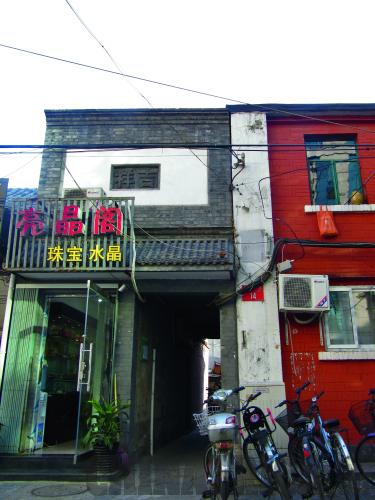| 
Yangrou Hutong is 600 years old. Located in the Xisi area of Beijing's Xicheng District, the area was originally a trading market for cattle, which usually ended up in the imperial kitchen. But with the name Yangrou (meaning mutton), butchers and mutton stores replaced the cattle traders starting in the Ming Dynasty (1368-1644). In those days, cries of sellers and the pungent smell of mutton overwhelmed every passerby.
But today, those smells and sounds are gone. Although Yangrou is situated next to a bustling street, the 5-meter-wide lane remains tranquil. The essence of mutton has been replaced with the glitter of jewels. The hutong has become a famous gem trading center in Beijing, with scores of jewelry shops and wholesalers running up and down the road.
Yangrou's jewelry shop owners keep a low profile, and it's easy to miss the shops entirely. There are no bold signs, nor zealous sellers looking to chase customers into stores. "Call me if you want an appointment," is all they offer with mild smiles.
The jewelry on Yangrou Hutong is famous for being "cheap and good." Because many customers are industry insiders it's irrational for shop owners to overprice their goods. Buyers can often get what they want at half the price, as compared to in a large shopping mall.
Yangrou's first block of jewelers came in the 1980s. China's Ministry of Land and Resources once occupied the lane, and many shops moved to the hutong to build up their credibility. Presently, there are over 30 jewelry outfits along the lane, but the area's fame has attracted more than 200 shops to settle nearby. The Beijing Jewelry Trading Center was also established on Yangrou Hutong several years ago.
With its long history, the street is not lacking in landmarks. Renovated in recent years, the building at No.77 appears fairly new, but its centuries-long saga makes it worth a second look.
In the 1870s, the address was the residence of Tan Zongjun, the founder of Tan's Cuisine, one of the most famous imperial cuisine restaurants still remaining in China. In his day, Tan was also a successful candidate in the highest of imperial examinations. Another important era for No.77 came in the 1930s when it housed a private hospital. Deng Yingchao, the wife of Zhou Enlai, the first premier of the People's Republic, was secretly moved to the hospice for care in those years.
The area is worth a visit for gourmands in particular. Quanjude, a restaurant on nearby Qianmen Street, is the largest roast duck dining establishment in the Chinese capital. Numerous visitors flood into the venue daily eager to try the Peking kaoya. In fact, the first ever Quanjude can be traced back to Yangrou Hutong; it opened in 1864. Due to its high standards, the restaurant's fame spread rapidly and for many years the demand for the famous roast duck nearly outstripped its supply.
Hutong Tips
How to get there
> By subway: Take subway Line 4 to Xisi Station
> By bus: Take bus 7/13/42/47/102/409/603/619 to Baitasi Station
What to buy
Zuanmengyuan is the most popular diamond store in Yangrou Hutong. People come here often to buy wedding rings at prices surprising to many grooms. The shop offers all kinds of gorgeous accoutrements. Prices are usually cheaper here than in big shopping malls elsewhere.
> Address: No. 30 Yangrou Hutong |